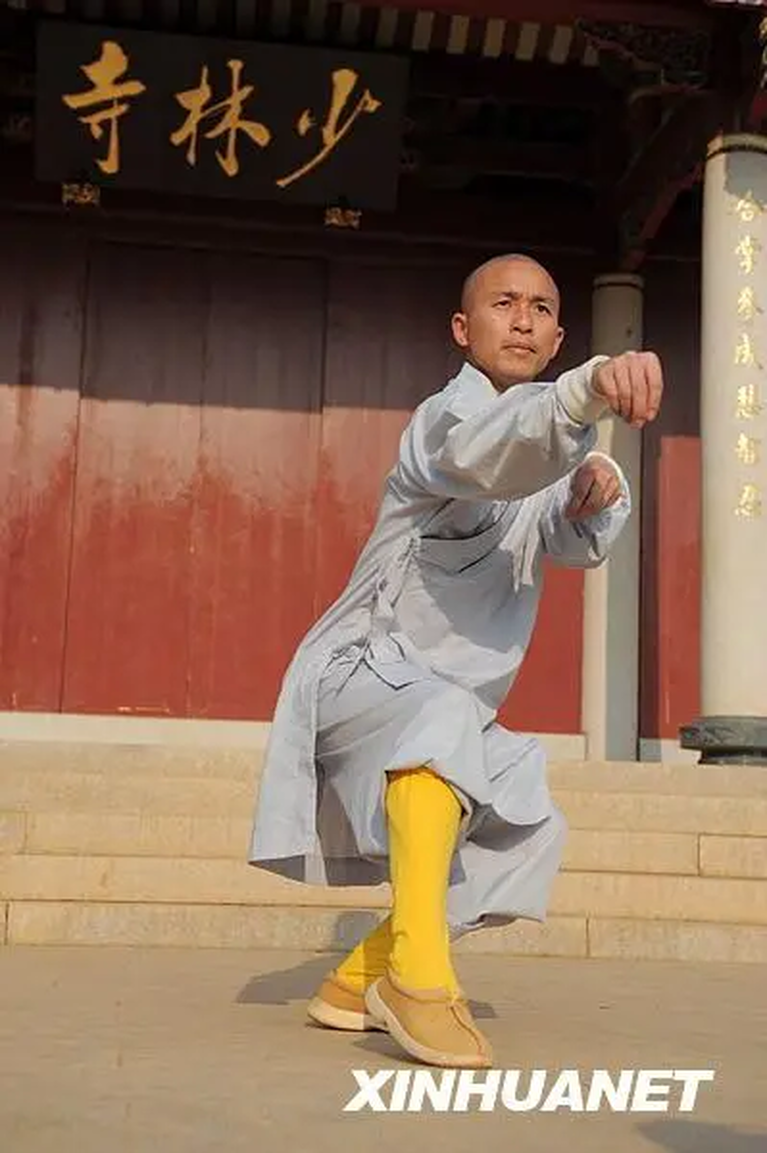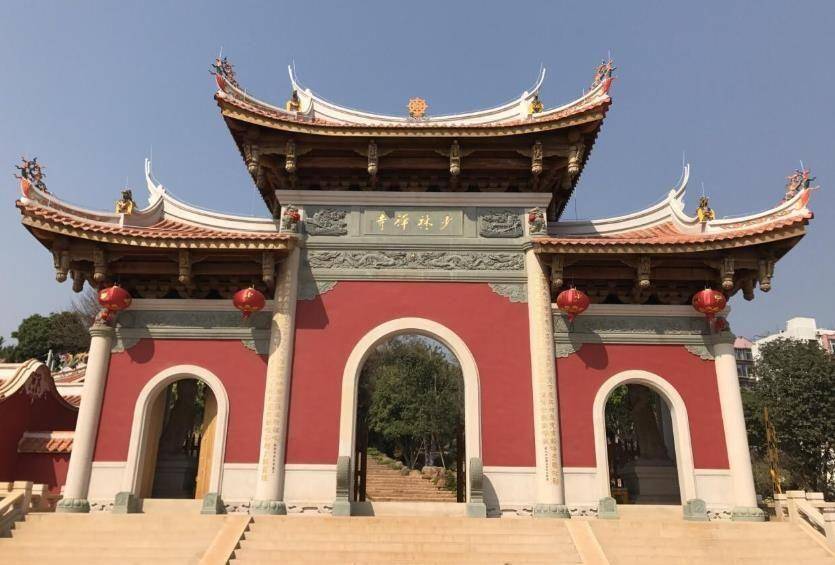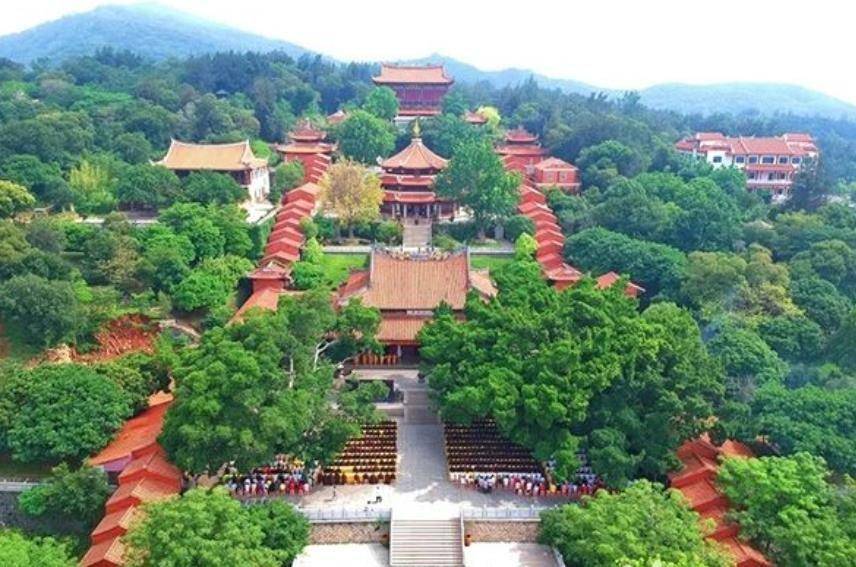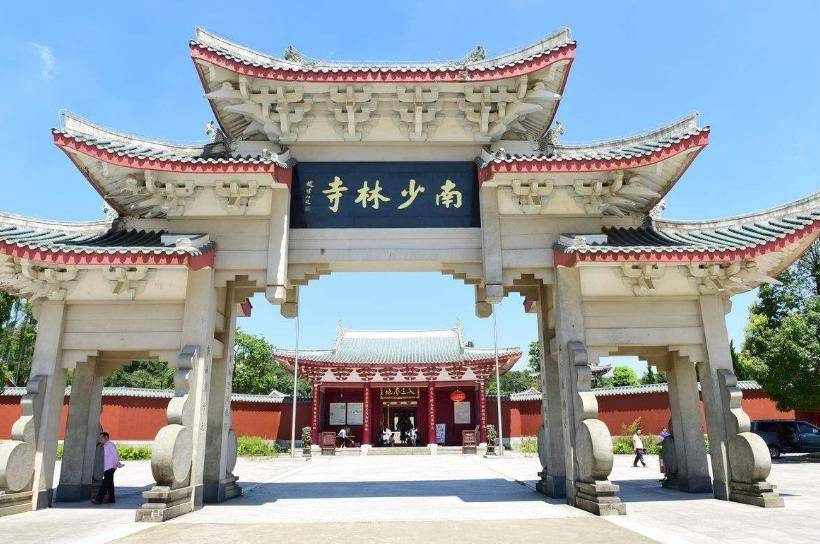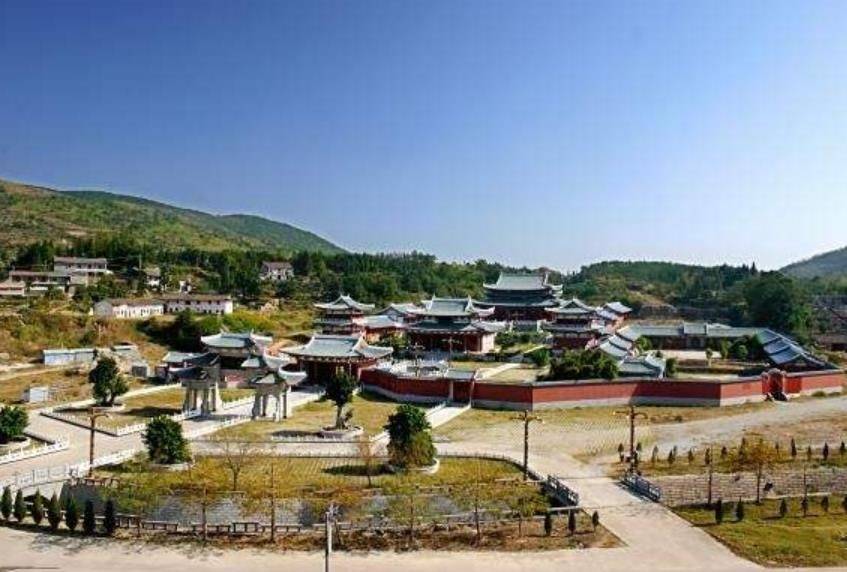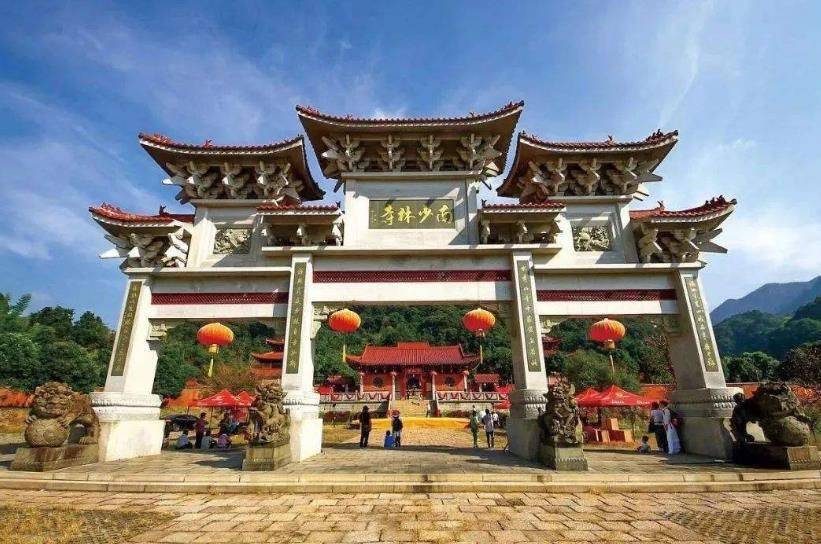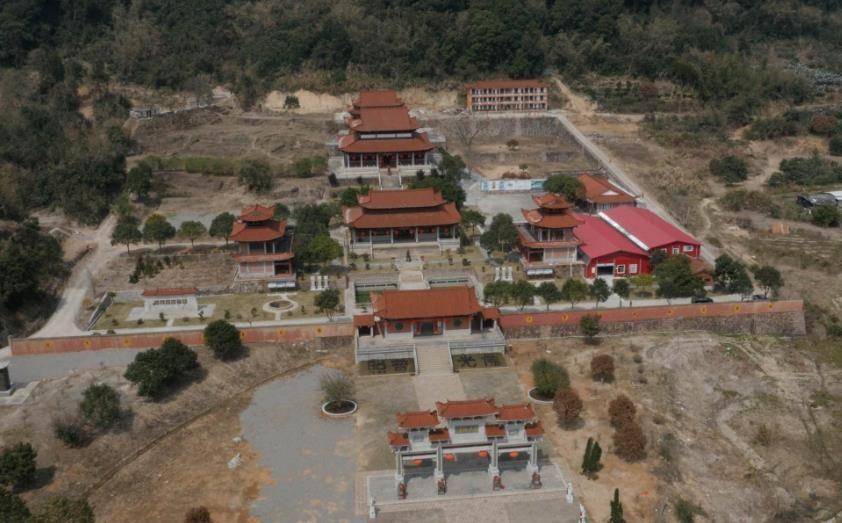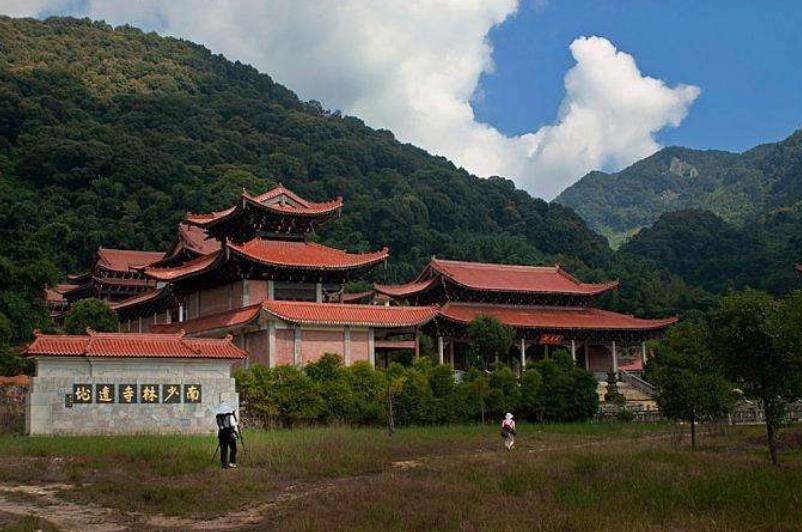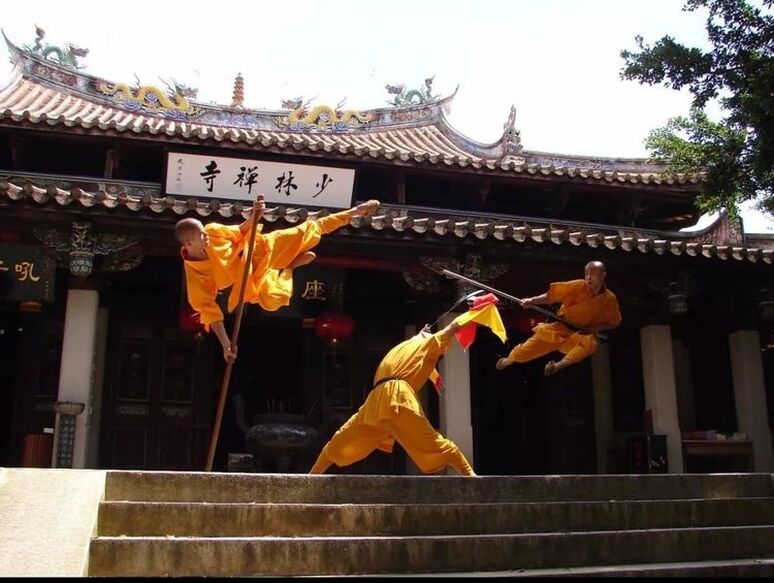The Three Southern Shaolin Temples!
The Songshan (嵩山) Shaolin (少林) Temple (寺 - Si) - situated in Henan province - is famous. There is, however, historical evidence that suggests another ‘Shaolin’ Temple existed in Fujian province. In order to distinguish it from the ‘Songshan’ Shaolin Temple, it is usually customary to refer to this other structure as the ‘Southern’ (南 - Nan) Shaolin Temple. A book was published around a hundred years ago – entitled the ‘Investigation of the Origin, Lineage and Tradition’ (教会源流考 - Jiao Hui Yuan Liu Kao) - which stated that the Henan Shaolin Temple had a sister-temple situated in Fujian province. An interesting point of historical observation is that the martial arts practiced in the Sothern Shaolin Temple differ from those practiced in the Henan Shaolin Temple! As matters stand today, there are three locations within Fujian province that all claim to be situated with the Southern Shaolin Temple tradition.
1) Quanzhou (泉州) - this is an ancient city which marked one of the main departure ports serving the Maritime Silk Road. The structure in question is the ‘Quanzhou Dongchan Shaolin Temple’ (泉州东禅少林寺 - Quan Zhan Dong Chan Shao Lin Si). The designation ‘Dong Chan’ (东禅) translates as ‘Eastern Meditation’. This temple is located in the ‘Qingyuan’ (清源) Mountain area of Quanzhou. This temple has always been associated with the 'Southern Ch’an’ lineage and the tradition of Southern Shaolin martial arts in China. According to history, a warrior-monk (武僧 - Wu Seng) - named ‘Zhikong’ (智空) - travelled from the Songshan Shaolin Temple in Henan (during the Tang Dynasty – 618-907 CE) and established the ‘Southern Shaolin Temple’. The monastic Buddhist name of ‘Zhikong’ (智空) translates as ‘Wisdom Void’. It is said that this temple has experienced three booms and three devastations. One of its greatest times of prosperity happened during the Song Dynasty (960-1276 CE). Today, the Quanzhou Shaolin Temple possesses a very good reputation throughout China, second only to that of the Songshan Shaolin Temple.
Historically, the Quanzhou Shaolin Temple has established a vast complex of buildings, however, the Dongchan Shaolin Temple comprises only a small part of the entire Quanzhou Shaolin Temple. Archaeologists have discovered a substantial number of important historical artifacts relating to the Southern Shaolin Temple – dating to the Tang and Song Dynasties. There is also an ancestral tower marking the ‘Five Ancestors of the Southern Shaolin’ (南少林五祖 - Nan Shao Lin Wu Zu) tradition nearby. This fact adds weight to the claim that the Quanzhan Shaolin Temple (or the ‘Dongchan’ part of it) is the ‘original’ Sothern Shaolin Temple. The problem is that paradoxically there have not yet been any discoveries of ancient plaques that specifically carrying the name ‘少林寺’ (Shaolin Temple).
2) Putian (莆田) - Putian is located between the Fuzhou and Quanzhou areas of Fujian province. It has been the political, economic and cultural centre of Fujian province since ancient times. The Southern Shaolin Temple is said to be situated in this area – and that the local people have an inherited collective memory of this fact. The Southern Shaolin Temple is believed to be situated in the ‘Forest Mountain’ (林山 - Lin Shan) Village area of Putian – which is located in the Qingyuan (清源) Mountain region of Fujian province. It is said that this candidate for the Southern Shaolin Temple was constructed during the ‘Yongding’ (永定) year (577 CE) of the Southern Dynasties. Originally, this building was known as the ‘Linquan’ (林泉) Temple (院 - Yuan) or ‘Forest Spring’ - with the variant ideogram used for ‘temple’ (院 - Yuan) referring to a ‘School’ or ‘Courtyard’ - which implies a place of learning above and beyond the usual study of the Dharma (Buddhist Teachings) – usually involving ‘medicine’ and ‘other’ cultural practices (such as martial arts). It is said that during the reign of the Tang Dynasty emperor – ‘Taizong' (太宗) - during the ‘Zhenguan’ (贞观) era years (627-649 CE), a number of warrior-monks from the Songshan Shaolin Temple travelled southward to the Linquan Temple and changed its name to the ‘Shaolin Temple’ (少林寺). This is why this temple is considered the birthplace of the ‘Southern Fist’ (南拳 - Nan Quan) martial arts tradition. Later, this Southern Shaolin Temple was burned down by Qing Dynasty soldiers – and was not rebuilt until 1989!
The Southern Shaolin Temple covers an area of 100,000 square meters. This complex consists of a ‘Mountain Gate’ (山门 - Shan Men), the ‘Lotus Pond’ (莲花池 - Lian Hua Chi), the ‘Divine-Sky King Hall’ (天王殿 - Tian Wang Dian), and the ‘Mahavira Hall’ (大雄宝殿 - Da Xiong Bao Dian) which all surround a central axis. Nearby is the ‘Ancient Bamboo Temple’ (古竹寺 - Gu Zhu Si), the ‘Xiawu’ (霞梧) Courtyard (院 - Yuan) - named after a geographical location of Fujian province - and the ‘Nine Lotus Rock’ (九莲岩 - Jiu Lian Yan), etc. Indeed, there are many other large and small monastic buildings surrounding the Southern Shaolin Temple. This reproduces the grandeur of the Ch’an Buddhist monastic system in the Ten Directions! The 29th ‘Head Monk’ (方丈 - Fang Zhang) of the Songshan Shaolin Temple named ‘Great Master’ (大师 - Da Shi) - ‘De Chan’ (德禅) - has stated that the Putian temple is the genuine Southern Shaolin Temple. Furthermore, the President of Chinese Buddhist Association - Zhao Puchu (赵朴初) - has also written that the temple at Putian is the Southern Shaolin Temple.
3) Fuqing (福清) - Fuqing is a county-level city that comes under the administrative control of Fuzhou. During 1993, the ‘Fujian Overseas Chinese News’ (福建侨报 - Fu Jian Qiao Bao) published an article entitled ‘Fuqing also has a Shaolin Temple’ (福清也有少林寺 - Fu Qing Ye You Shao Lin Si). The Fuqing Southern Shaolin Temple site is located at the foot of the Daiyun (戴云) Mountains (山 - Shan) situated in Fuqing. It was constructed during the Tang Dynasty – but was later destroyed during warfare. During 1994, the Fuqing Authorities rebuilt the Southern Shaolin Temple on what is believed to be the site of the original Tang Dynasty Shaolin Temple. This temple is ornate and contains a number of beautiful archways, a ‘Mountain Gate’ (山门 - Shan Men), a ‘Divine-Sky King Hall’ (天王殿 - Tian Wang Dian), a ‘Mahavira Hall’ (大雄宝殿 - Da Xiong Bao Dian) and a ‘Patriarch Bodhidharma Hall’ (达摩祖师殿 - Da Mo Zu Shi Dian), etc. There is a belief that this temple site is around one-thousand years old.
In the past, archaeological teams have uncovered ancient name plaques in the ruins of the site that carries the characters ‘Shaolin Temple’ (少林院 - Shao Lin Yuan). The character used for temple in this example is ‘院’ (Yuan) - implying a ‘School’ or ‘Courtyard’ of educational excellence. There are many stone inscriptions containing the name ‘Shaolin’ (少林) together with other numerous historical relics. When all this archaeological evidence is combined with extant documentary records, there is strong evidence to support the claim that the Fuqing site is the genuine location of the Southern Shaolin Temple as described in the history books. This is further supported by the fact that the 33rd Generation Master of the Songshan Shaolin Temple – named ‘Shi Yongshou’ (释永寿) - once visited the Fuqing site and stated that this is the historical Southern Shaolin Temple. He stated that evidence held at the Songshan Shaolin Temple supported this idea.
In ancient times, there were two Shaolin Temples known to have existed – one in the North and one in the South of China – that is to say a Shaolin Temple in Zhongzhou (Henan) and the another in Fujian. Although the location of the ‘Northern’ Shaolin Temple is well-known and has been continuously occupied for over 1,500 years, the site of the Southern Shaolin Temple is under dispute. There are currently three candidates for this title – all of which fiercely support their own claims to this unique cultural heritage whilst completely dismissing and ignoring the assertions of their fellow contenders! This is a highly contentious issue with many historians holding diverse and differing opinions. Each of the three temples appear to be genuine but no one can ascertain why there are ‘three’ differing and completely different temples all claiming a direct lineal link with the Songshan Shaolin Temple! All practice Ch’an meditation, all preserve, maintain and practice medicine, and all uphold a tradition of Southern Chinese martial arts. Finally, all three temples possess an ‘Internationalist’ attitude and are willing to transmit their teachings to anyone who wants to genuinely learn.
©opyright: Adrian Chan-Wyles (ShiDaDao) 2022.
©opyright: Adrian Chan-Wyles (ShiDaDao) 2022.
Chinese Language Article:
http://www.sohu.com/a/416043641_100146715
南少林寺到底在哪里?福建这三个地方都说与其有关,你认为哪个是
2020-09-05 08:14
说到少林寺,大家知道的就是嵩山少林寺了,在福建也有一座少林寺,为了把它和嵩山少林寺分清,习惯上把它称为南少林。百年前的《教会源流考》书中说道:福建也有少林寺,然与河南少林寺不同。但是这个少林寺在福建什么地方,很遗憾书中并没有说,现在有三座城市据说是南少林所在地,来看看是哪里吧。
泉州,一座古老的城市,是海上丝绸之路的始发港之一。泉州东禅少林寺,位于泉州清源山,一向为我国南禅及南少林武术之中心,相传为唐初嵩山少林寺武僧智空入闽所建,始建于唐朝,兴盛于两宋,历经三废三兴。现在泉州少林寺的影响力还是很大的,名声仅次于嵩山少林寺。
历史上的泉州少林寺是一个庞大建筑群,现存的东禅少林寺仅是泉州少林寺的一小部分。考古专家曾经在这里挖出了大量唐宋时期南少林寺的建筑构件,又发现附近有一处“南少林五祖”之一的墓塔,印证了南少林也许就是在泉州,不过,这里没有找到记载“少林寺”字样的东西,还不能服众。
莆田位于福州泉州之间,自古是闽中的政治、经济、文化中心,南少林寺就在这里,据说是得到很多人认可。南少林位于莆田清源山下林山村境内,建于南朝永定年间(公元577年),当时叫做林泉院,唐太宗贞观年间,嵩山少林寺僧人南下来到这里,把林泉院改为少林寺,使它成为南拳的发祥地,后来南少林寺被清兵所焚毁,1989年开始重建。
南少林寺占地面积十万平方米,由山门、莲花池、天王殿、大雄宝殿等组成中轴线,周围的古竹寺、霞梧院、九莲岩等大小寺院环绕着南少林寺,重现了当年十方丛林的恢宏气度。嵩山少林寺第29代方丈德禅大师认定莆田林泉院为南少林寺所在地,中国佛教会长赵朴初题写“南少林寺”寺名。
福清,是个县级市,由福州代管,1993年《福建侨报》发表《福清也有少林寺》的文章,福清南少林遗址坐落于福清戴云山脉下,始建于唐代,毁于战乱,1994年,福清在原少林寺遗址上重建南少林。寺庙内建有牌坊、山门、天王殿、大雄宝殿、达摩祖师殿等,已初现千年古刹当年的风貌。
以前考古队在福清少林寺遗址发现“少林院”、“少林”等石刻铭文,还有很多的历史文物,结合文献记载,他们认定福清少林寺与历史书中记载的南少林比较相似。嵩山少林寺三十三代法师释永寿曾经到过这里考察,他认为福清南少林寺的寺址是名副其实的南少林寺遗址。
世传古代有南北两座少林寺:一座在中州,一座在闽中。南少林到底是在哪里,则众说纷纭,以莆田和泉州的争执尤为激烈,现在又有莆田加入,三个地方都有自己的证据,相信会有一天揭开南少林的神秘面纱,恢复其历史的本来面目。返回搜狐,查看更多
http://www.sohu.com/a/416043641_100146715
南少林寺到底在哪里?福建这三个地方都说与其有关,你认为哪个是
2020-09-05 08:14
说到少林寺,大家知道的就是嵩山少林寺了,在福建也有一座少林寺,为了把它和嵩山少林寺分清,习惯上把它称为南少林。百年前的《教会源流考》书中说道:福建也有少林寺,然与河南少林寺不同。但是这个少林寺在福建什么地方,很遗憾书中并没有说,现在有三座城市据说是南少林所在地,来看看是哪里吧。
泉州,一座古老的城市,是海上丝绸之路的始发港之一。泉州东禅少林寺,位于泉州清源山,一向为我国南禅及南少林武术之中心,相传为唐初嵩山少林寺武僧智空入闽所建,始建于唐朝,兴盛于两宋,历经三废三兴。现在泉州少林寺的影响力还是很大的,名声仅次于嵩山少林寺。
历史上的泉州少林寺是一个庞大建筑群,现存的东禅少林寺仅是泉州少林寺的一小部分。考古专家曾经在这里挖出了大量唐宋时期南少林寺的建筑构件,又发现附近有一处“南少林五祖”之一的墓塔,印证了南少林也许就是在泉州,不过,这里没有找到记载“少林寺”字样的东西,还不能服众。
莆田位于福州泉州之间,自古是闽中的政治、经济、文化中心,南少林寺就在这里,据说是得到很多人认可。南少林位于莆田清源山下林山村境内,建于南朝永定年间(公元577年),当时叫做林泉院,唐太宗贞观年间,嵩山少林寺僧人南下来到这里,把林泉院改为少林寺,使它成为南拳的发祥地,后来南少林寺被清兵所焚毁,1989年开始重建。
南少林寺占地面积十万平方米,由山门、莲花池、天王殿、大雄宝殿等组成中轴线,周围的古竹寺、霞梧院、九莲岩等大小寺院环绕着南少林寺,重现了当年十方丛林的恢宏气度。嵩山少林寺第29代方丈德禅大师认定莆田林泉院为南少林寺所在地,中国佛教会长赵朴初题写“南少林寺”寺名。
福清,是个县级市,由福州代管,1993年《福建侨报》发表《福清也有少林寺》的文章,福清南少林遗址坐落于福清戴云山脉下,始建于唐代,毁于战乱,1994年,福清在原少林寺遗址上重建南少林。寺庙内建有牌坊、山门、天王殿、大雄宝殿、达摩祖师殿等,已初现千年古刹当年的风貌。
以前考古队在福清少林寺遗址发现“少林院”、“少林”等石刻铭文,还有很多的历史文物,结合文献记载,他们认定福清少林寺与历史书中记载的南少林比较相似。嵩山少林寺三十三代法师释永寿曾经到过这里考察,他认为福清南少林寺的寺址是名副其实的南少林寺遗址。
世传古代有南北两座少林寺:一座在中州,一座在闽中。南少林到底是在哪里,则众说纷纭,以莆田和泉州的争执尤为激烈,现在又有莆田加入,三个地方都有自己的证据,相信会有一天揭开南少林的神秘面纱,恢复其历史的本来面目。返回搜狐,查看更多
